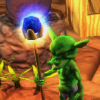I'm not good at pixelling or other 2d art myself, but here is some advice.
Remember that except for real life, anything digital that you see is already frame by frame, including movies, 3d games, etc... Of course the actual framerate varies, but the same rule applies. So, take a look at something similar to what you want. If you are interested in low-rez pixel art, take a look at similar games like old mario, zelda, final fantasy, etc... You could go even older to Atari style but there isn't any shading in those sprites really due to hardware limitations. But NES, SNES, Commodore 64, among others are great examples as they started having shading by then. The same rules apply if you want to do different styles, including higher resolution pixel art, brush art(or whatever you call it), vector art, whatever.
So, remembering the rule above about things working frame by frame, note that your eyes work out the in-betweens most of the time as long as you have enough frames. Pixel art generally got away with only 4 - 8 frames for a walk cycle, and it was enough, and did not look bad. Higher resolution art requires more frames for things though, as there is simply more information for the eyes to process and it gets jerky to the viewer without more frames.
So, just draw the frames and adjust the lighting to be from the same direction. Our eyes will work it out, especially if it is low-rez pixel art. Just remember in general what is light and what is dark. If my character is a kangaroo, and my lighting is from the upper right, the stomach of the kangaroo will by light nuetral to dark, as it is facing away from the light but isn't exactly in shadow either. But if I have an animation where he/she leans back on the tail(to kick the feet up), then that same stomach area will now be facing the light and need to be brighter shade of the same color in the palette, while the head will be more in shadow depending on how far back the head goes.
Though I mostly talk about pixel art, the above applies to all types of art, even 3d though it is usually automatic from lighting in the engine. If you do vector art, you will have shapes and gradients for lighting(depending on the style you choose), so you would possible move those around some too, unless you want the lighting to not adjust on your objects as animation happens. Some games do that, but I don't like it that much.









